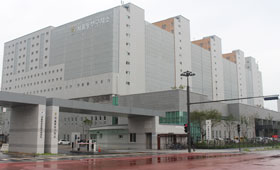Kojoseon Dynasty (BC 2333~108)
- A nation which has an independent organization responsible for penal code execution
- Ransom system replacing punishment
Buyeo Dynasty (BC 425~494)
- Release of inmates when‘ Yeong-go(a national festival)’is held
- Builds and uses a unique round-typed prison
Shilla Dynasty (BC 57~935)
- practices amnesty system
- public office working for criminal administration-left, right public office
Baekje Dynasty (BC 18~660)
- practices amnesty system
- opportunity of double trials for felonry - review system
- public office responsible for penal rules and prisons Jojeongjwapyoeng
Koryeo Dynasty (918~1392)
- Independent penal code facility - Jeonokseo
- 5 penal system - flogging, lashing, penal servitude, banishment and capital punishment
- Triple review system for death-row convicts, a system of explanation by three persons for suspects
- System which provides vacation for detained prisoners - Bobangje
Chosun Dynasty (1392~1910)

- Compiles and organizes laws and rules including the Joseon Code - based on rule of law
- Death penalty’ extended to exile punishment
- Codification of standards and procedure of and how to use implements of punishment - prevents abusive punishment
Since the Kabo Reform of 1894
- Establishes prison rules - arranged for modern imprisonment execution law
1898
- Establishes detailed imprisonment
- Detainee's works, writing letters, reception, pay - sets up treatment standards for inmates
⇒ failed by the Japanese colonial rule
Period of the Japanese colonial rule of Korea.
- Japanese imprisonment law applied to the domestic law.
- Promotes extension of facilities ⇒used for the Japanese colonial rule resulting in abused human rights of inmates.
1912

- Kyeongseong prison was the first modern correctioanl facility which accommodated long term prisoners.
1914

- Ok, a traditional detention camp, had circular shape fence symbolizing the hope that prisoners improve for themselves.
Under the US military administration
- Introduces advanced corrections systems like Good Time System ⇒ little fruition due to time limits
1948
- Establishes the Korean Government
1950
- Enacts penal code - base for democratic corrections ⇒ breaks out the Korean War - frustrated
1955

- literacy education for inmates
1955

- the 8th day of prison officers
1960

- Rapidly economic development - Miracle of Han River
- Continuous construction and reconstruction of corrections facilities
- 11 time-revisions of penal code ⇒ leaps towards advanced corrections
- Pharmacy (Masan prison)
1975

- Vocational training (Daejeon prison)
1980

- Opens Cheonan open correctional institution
1988
- Allows for prisoners to write, read newspapers and watch TV
- Builds open correctional institution and women correctional institution - diversified in corrections facilities
1989
- Three-shift system for night duty
1999

- Introduces family meeting house for inmates and their family
2003
- Online visitation system
2006

- Extended space per prisoner
- Four-shift system for night duty
- Free reception without staff involvement 2006. 10 -Opens Pohang correctional institution
- Introduces domestic first electric security system
2008
- launches Korea Correctional Service of the Ministry of Justice
2009

- Extends convenient facilities for the disabled / Enhances living conditions
- Opens Hwaseong correctional institution for vocational training
- Introduces tele medical care system
2009

- Opens Halfway house (the house of hope)
2010

- Opening of Somang Correctional Institution
2010

- Opening of the Prison Radio Broadcasting Network
2011

- Transfer of Seoul Nambu Correctional Institution
2011

- Opening of Reformation Psychological Treatment Center
2011

- Opening of Yeongwol Correctional Institution
2012
- Opens Comprehensive Reformation Center for Disabled Inmates, the Mental Health Center
2013

- Implements Internet video visit
2014
- Conducts Intensive Personality Education
2015

- Implements Smart phone visit
2016

- Opens Psychological Treatment Division
2017

- Transfer of Seoul Dongbu Detention Center

- Opens Correctional Service Call Center